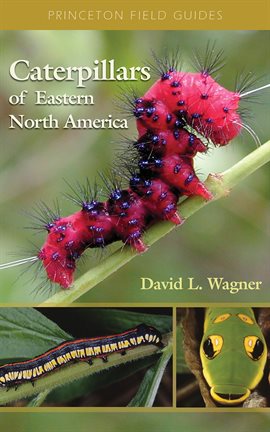
eBook
hoopla Instant
Caterpillars of Eastern North America
Year
2010
Language
ENGLISH
Publication Information
Princeton University Press
Summary
David L. Wagner is Associate Professor of Ecology and Evolutionary Biology at the University of Connecticut. He is coauthor of two United States Forest Service guides, Caterpillars of Eastern Forests and Geometroid Caterpillars of Northeastern and Appalachian Forests. This lavishly illustrated guide will enable you to identify the caterpillars of nearly 700 butterflies and moths found east of the Mississippi. The more than 1,200 color photographs and two dozen line drawings include numerous exceptionally striking images. The giant silk moths, tiger moths, and many other species covered include forest pests, common garden guests, economically important species, and of course, the Mescal Worm and Mexican Jumping Bean caterpillars. Full-page species accounts cover almost 400 species, with up to six images per species including an image of the adult plus succinct text with information on distribution, seasonal activity, foodplants, and life history. These accounts are generously complemented with additional images of earlier instars, closely related species, noteworthy behaviors, and other intriguing aspects of caterpillar biology. Many caterpillars are illustrated here for the first time. Dozens of new foodplant records are presented and erroneous records are corrected. The book provides considerable information on the distribution, biology, and taxonomy of caterpillars beyond that available in other popular works on Eastern butterflies and moths. The introductory chapter covers caterpillar structure, life cycles, rearing, natural enemies, photography, and conservation. The section titled "Caterpillar Projects" will be of special interest to educators. Given the dearth of accessible guides on the identification and natural history of caterpillars, Caterpillars of Eastern North America is a must for entomologists and museum curators, forest managers, conservation biologists and others who seek a compact, easy-to-use guide to the caterpillars of this vast region. • A compact guide to nearly 700 caterpillars east of the Mississippi, from forest pests to garden guests and economically important species • 1,200 color photos and 24 line drawings enable easy identification • Full-page species accounts with image of adult insect for almost 400 species, plus succinct text on distribution and other vital information • Many caterpillars illustrated here for the first time • Current information on distribution, biology, and taxonomy not found in other popular works • A section geared toward educators, "Caterpillar Projects" • An indispensable resource for all who seek an easy-to-use guide to the caterpillars of this vast region "A lusciously photographed book generally regarded as the most comprehensive field guide ever to caterpillars, as opposed to their better-documented adult forms--moths and butterflies. . . . In the book, the fruit of a decade's research, Dr. Wagner . . . argues passionately that creeping things can be every bit as mesmerizing and transporting as those that flit and dart in the air."---Andy Newman, New York Times "This is a wonderful field guide for those interested in studying the fascinating world of caterpillars in the backyard, parks, woods and fields around us."---Robert E. Hoopes, Wildlife Activist "David Wagner has produced a user-friendly field guide that goes well beyond anything else available." "As a teacher of the university courses in insect biology and classification, I will use this book heavily; yet it is attractive and simply written enough to be much more widely appealing for children, teachers, and indeed anyone with interest in naturally history. David Wagner is to be congratulated for communicating his knowledge of the Lepidoptera so clearly and appealingly to the rest of us."---J.B. Whitfield, Annals of the Entomological Society of America "In general, the images of caterpillars and adults in this book are superb, the